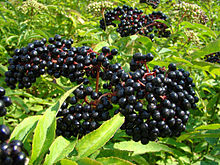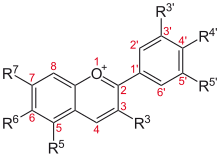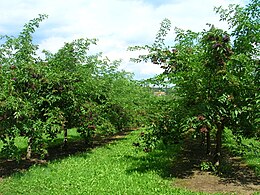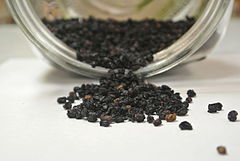Sambucus
| Sambucus | |
|---|---|

| |
| Sambucus berries (elderberries) | |
| Scientific classification | |
| Kingdom: | Plantae |
| Clade: | Tracheophytes |
| Clade: | Angiosperms |
| Clade: | Eudicots |
| Clade: | Asterids |
| Order: | Dipsacales |
| Family: | Adoxaceae |
| Genus: | Sambucus L.[1] |
| Species | |
Sambucus is a genus of flowering plants in the family Adoxaceae. The various species are commonly referred to as elder, elderflower or elderberry.
Description
The oppositely arranged leaves are pinnate with 5–9 leaflets (or, rarely, 3 or 11). Each leaf is 5–30 centimetres (2–12 in) long, and the leaflets have serrated margins. They bear large clusters of small white or cream-colored flowers in late spring; these are followed by clusters of small black, blue-black, or red berries (rarely yellow or white).
-
S. canadensis branches and inflorescence
-
Inflorescence of S. canadensis
-
Flowers of S. nigra

Chemistry
Sambucus fruit is rich in anthocyanidins[3] that combine to give elderberry juice an intense blue-purple coloration that turns reddish on dilution with water.[4]
Taxonomy
The taxonomy of the genus Sambucus L., originally described by Carl Linnaeus and hence its botanical authority, has been complicated by its wide geographical distribution and morphological diversity. This has led to overdescription of the species and infraspecific taxa (subspecies, varieties or forms).[5]
The genus was formerly placed in the honeysuckle family, Caprifoliaceae, but was reclassified as Adoxaceae due to genetic and morphological comparisons to plants in the genus Adoxa.
Species recognized in this genus are:[6][7]
- Sambucus adnata – Himalaya and eastern Asia
- Sambucus australasica – New Guinea, eastern Australia
- Sambucus australis – South America
- Sambucus canadensis – eastern North America
- Sambucus cerulea – western North America
- Sambucus ebulus – central and southern Europe, northwest Africa and southwest Asia
- Sambucus gaudichaudiana – south eastern Australia
- Sambucus javanica – southeastern Asia
- Sambucus lanceolata – Madeira Island
- Sambucus latipinna – Korea, southeast Siberia
- Sambucus melanocarpa – western North America
- Sambucus microbotrys – southwest North America
- Sambucus nigra – Europe and North America
- Sambucus orbiculata[a] – western North America
- Sambucus palmensis – Canary Islands
- Sambucus peruviana – Costa Rica, Panama and northwest South America
- Sambucus pubens – northern North America
- Sambucus racemosa – northern, central and southeastern Europe, northwest Asia, western North America
- Sambucus sibirica – eastern Asia
- Sambucus sieboldiana – Japan and Korea
- Sambucus simpsonii – southeastern United States
- Sambucus tigranii – southwest Asia
- Sambucus velutina – southwestern North America
- Sambucus wightiana – western Himalayas
- Sambucus williamsii – northeast Asia
Etymology
The name comes from the Ancient Greek word σαμβύκη (sambū́kē), an ancient wind instrument, about the removal of pith from the twigs to make whistles.[8]
Distribution and habitat
The genus occurs in temperate to subtropical regions of the world. More widespread in the Northern Hemisphere, its Southern Hemisphere occurrence is restricted to parts of Australasia and South America. Many species are widely cultivated for their ornamental leaves, flowers, and fruit.[9]
Elder commonly grows near farms and homesteads. It is a nitrogen-dependent plant and thus is generally found near places of organic waste disposal. Elders are often grown as a hedgerow plant in Britain since they take very fast, can be bent into shape easily, and grow quite profusely, thus having gained the reputation of being 'an instant hedge'. It is not generally affected by soil type or pH level and will virtually grow anywhere sufficient sunlight is available.
Ecology
S. callicarpa berries are consumed by birds and mammals.[10] In Northern California, elderberries are eaten by migrating band-tailed pigeons. Elders are used as food plants by the larvae of some Lepidoptera species including brown-tail, buff ermine, dot moth, emperor moth, engrailed moth, swallow-tailed moth and the V-pug. The crushed foliage and immature fruit have a strong fetid smell. Valley elderberry longhorn beetles in California are very often found around red or blue elderberry bushes. Females lay their eggs on the bark.[11] Strong-scented flowers in wild populations of European elder (S. nigra) attract numerous, minute flower thrips which may contribute to the transfer of pollen between inflorescences.[12]

Cultivation
Traditional uses of Sambucus involved berries, seeds, leaves, and flowers or component extracts.[13] Ornamental varieties of Sambucus are grown in gardens for their showy flowers, fruits and lacy foliage which support habitat for wildlife.[14] Of the many native species, three are used as ornamentals: S. canadensis, S. nigra, and S. racemosa.[15]
Toxicity
The uncooked berries and other parts of plants from this genus are poisonous.[16][10] Leaves, twigs, branches, seeds, roots, flowers, and berries of Sambucus plants produce cyanogenic glycosides, which have toxic properties.[16] Ingesting a sufficient quantity of cyanogenic glycosides from berry juice, flower tea, or beverages made from fresh leaves, branches, and fruit has been shown to cause illness, including nausea, vomiting, abdominal cramps, diarrhea, and weakness.[17][16][18] In August 1983, a group of 25 people in Monterey County, California, became ill after ingesting elderberry juice pressed from fresh, uncooked S. mexicana berries, leaves, and stems.[18] The concentration of cyanogenic glycosides is higher in tea made from flowers (or leaves) than from the berries.[16][19]
The seeds of S. callicarpa are reported to be poisonous and may cause vomiting or diarrhea.[10]
| Nutritional value per 100 g (3.5 oz) | |
|---|---|
| Energy | 305 kJ (73 kcal) |
18.4 g | |
| Dietary fiber | 7 g |
0.5 g | |
0.66 g | |
| Vitamins | Quantity %DV† |
| Vitamin A equiv. | 3% 30 μg |
| Thiamine (B1) | 6% 0.07 mg |
| Riboflavin (B2) | 5% 0.06 mg |
| Niacin (B3) | 3% 0.5 mg |
| Pantothenic acid (B5) | 3% 0.14 mg |
| Vitamin B6 | 14% 0.23 mg |
| Folate (B9) | 2% 6 μg |
| Vitamin C | 40% 36 mg |
| Minerals | Quantity %DV† |
| Calcium | 3% 38 mg |
| Iron | 9% 1.6 mg |
| Magnesium | 1% 5 mg |
| Phosphorus | 3% 39 mg |
| Potassium | 9% 280 mg |
| Zinc | 1% 0.11 mg |
| Other constituents | Quantity |
| Water | 79.80 g |
| †Percentages estimated using US recommendations for adults,[20] except for potassium, which is estimated based on expert recommendation from the National Academies.[21] | |
Uses
The cooked berries (pulp and skin) of most species of Sambucus are edible.[17][22]
Nutrition
Raw elderberries are 80% water, 18% carbohydrates, and less than 1% each of protein and fat. In a 100-gram (3+1⁄2 oz) amount, elderberries supply 305 kilojoules (73 kcal) of food energy and are a rich source of vitamin C, providing 43% of the Daily Value (DV). Elderberries also have moderate contents of vitamin B6 (18% DV) and iron (12% DV), with no other nutrients in significant content.
Dietary supplement
Elderberry fruit or flowers are used as dietary supplements to prevent or provide relief from minor diseases, such as flu, colds, constipation, and other conditions, served as a tea, extract or in a capsule.[17] The use of elderberry supplements increased early in the COVID-19 pandemic.[23] There is insufficient research to establish its effectiveness for such uses, or its safety profile.[17] The raw or unripe fruit of S. nigra or its extracts may contain a cyanogenic glycoside that is potentially toxic.[23]
Traditional medicine
Although practitioners of traditional medicine have used elderberry over centuries,[14] there is little high-quality clinical evidence that such practices provide benefits, though the US National Institutes of Health have stated that "some preliminary research suggests that elderberry may relieve symptoms of flu or other upper respiratory infections."[17]
Pigments
The pigments are used as colorants in various products,[3] and "elderberry juice color" is listed by the US Food and Drug Administration as allowable in certified organic food products.[3] In Japan, elderberry juice is listed as an approved "natural color additive" under the Food and Sanitation Law.[24] Fibers can be dyed with elderberry juice (using alum as a mordant) to give a "muted purple" shade.[25][26]

Other
The berry of S. callicarpa can be made into wine.[10] The flowers of S. nigra are used to produce elderflower cordial. St-Germain, a French liqueur, is made from elderflowers. Hallands Fläder, a Swedish akvavit, is flavoured with elderflowers.
Hollowed elderberry twigs have traditionally been used as spiles to tap maple trees for syrup.[27] Additionally, they have been hollowed out and used as flutes, blowguns, and syringes.[28] In addition, the elderberry twigs and fruit are employed in creating dyes for basketry. These stems are dyed a very deep black by soaking them in a wash made from the berry stems of the elderberry.[14]
The pith of elder has been used by watchmakers for cleaning tools before intricate work.[29]
In culture
Folklore related to elder trees is extensive and can vary according to region.[30] In some traditions, the elder tree is thought to ward off evil and give protection from witches, while other beliefs say that witches often congregate under the plant, especially when it is full of fruit.[31] If an elder tree was cut down, a spirit known as the Elder Mother would be released and take her revenge.[32] The tree could only safely be cut while chanting a rhyme to the Elder Mother.[33] Romani people believe burning elder wood brings bad luck.[34]
Elton John's 1973 album Don't Shoot Me I'm Only the Piano Player features a song titled "Elderberry Wine".
A wand made from the branch of an elder tree plays a pivotal role in the final book of the Harry Potter series, which was almost named Harry Potter and the Elder Wand.[35][36]
Notes
- ^ Wikispecies lists Sambucus orbiculata as a synonym for Sambucus canadensis
References
- ^ "Sambucus L". Germplasm Resource Information Network. United States Department of Agriculture. 2005-10-13. Archived from the original on 2009-05-07. Retrieved 2009-07-23.
- ^ Johnson, M. C; Thomas, A. L; Greenlief, C. M (2015). "Impact of Frozen Storage on the Anthocyanin and Polyphenol Content of American Elderberry Fruit Juice". Journal of Agricultural and Food Chemistry. 63 (23): 5653–5659. doi:10.1021/acs.jafc.5b01702. PMC 4472577. PMID 26028422.
- ^ a b c Colors Derived from Agricultural Products, USDA
- ^ "National Organic Program (NOP)-Proposed Amendments to the National List of Allowed and Prohibited Substances (Processing)". Federal Register. May 15, 2007.
- ^ Applequist 2015.
- ^ TPL 2013.
- ^ Eriksson & Donoghue 1997.
- ^ Niering, William A.; Olmstead, Nancy C. (1985) [1979]. The Audubon Society Field Guide to North American Wildflowers, Eastern Region. Knopf. p. 448. ISBN 0-394-50432-1.
- ^ RHS A-Z encyclopedia of garden plants. United Kingdom: Dorling Kindersley. 2008. p. 1136. ISBN 978-1-4053-3296-5.
- ^ a b c d Whitney, Stephen (1985). Western Forests (The Audubon Society Nature Guides). New York: Knopf. p. 423. ISBN 0-394-73127-1.
- ^ "Asian Long-Horned Beetle Life Cycle, Development & Life Stages". Orkin.com. 2018-04-11. Retrieved 2020-12-25.
- ^ Scott-Brown, A.S.; Arnold, S.E.J.; Kite, G.C.; Farrell, I.F.; Farman, D.I.; Collins, D.W.; Stevenson, P.C. (2019). "Mechanisms in mutualisms: A chemically mediated thrips pollination strategy in common elder". Planta. 250 (1): 367–379. Bibcode:2019Plant.250..367S. doi:10.1007/s00425-019-03176-5. PMID 31069523. S2CID 253886497.
- ^ Gayle Engels; Josef Brinckmann (2013). "European elder, Sambucus nigra, L." HerbalGram, American Botanical Council. Retrieved 21 October 2019.
- ^ a b c Stevens M (2001). "Guide for common elderberry (Sambucus nigra L. ssp. Canadensis (L.)" (PDF). National Resources Conservation Service, US Department of Agriculture. Retrieved 21 October 2019.
- ^ Boland 2012.
- ^ a b c d Senica, M; Stampar, F; Veberic, R; Mikulic-Petkovsek, M (2016). "The higher the better? Differences in phenolics and cyanogenic glycosides in Sambucus nigra leaves, flowers and berries from different altitudes". Journal of the Science of Food and Agriculture. 97 (8): 2623–2632. doi:10.1002/jsfa.8085. PMID 27734518.
- ^ a b c d e "European elder". National Center for Complementary and Integrative Health, US National Institutes of Health. September 2016. Retrieved 8 November 2016.
- ^ a b Centers for Disease Control (CDC) (April 6, 1984). "Poisoning from Elderberry Juice—California". Morbidity and Mortality Weekly Report. 33 (13): 173–174. PMID 6422238. Retrieved December 15, 2012.
- ^ Viapiana, A; Wesolowski, M (2017). "The Phenolic Contents and Antioxidant Activities of Infusions of Sambucus nigra L". Plant Foods for Human Nutrition. 72 (1): 82–87. doi:10.1007/s11130-016-0594-x. PMC 5325840. PMID 28084608.
- ^ United States Food and Drug Administration (2024). "Daily Value on the Nutrition and Supplement Facts Labels". Retrieved 2024-03-28.
- ^ National Academies of Sciences, Engineering, and Medicine; Health and Medicine Division; Food and Nutrition Board; Committee to Review the Dietary Reference Intakes for Sodium and Potassium (2019). Oria, Maria; Harrison, Meghan; Stallings, Virginia A. (eds.). Dietary Reference Intakes for Sodium and Potassium. The National Academies Collection: Reports funded by National Institutes of Health. Washington (DC): National Academies Press (US). ISBN 978-0-309-48834-1. PMID 30844154.
{{cite book}}: CS1 maint: multiple names: authors list (link) - ^ McVicar, Jekka (2007). "Jekka's Complete Herb Book" p. 214–215. Raincoast Books, Vancouver. ISBN 1-55192-882-5
- ^ a b "Dietary Supplements in the Time of COVID-19: Fact Sheet for Health Professionals". National Institutes of Health, Office of Dietary Supplements. 5 October 2021. Retrieved 16 December 2021.
- ^ Processing Fruits: Science and Technology (Second ed.). CRC Press. 2004. pp. 322–324. ISBN 9781420040074. Retrieved 20 August 2018.
- ^ Burgess, Rebecca (2011). Harvesting Color: How to Find Plants and Make Natural Dyes. Artisan Books. pp. 74–75. ISBN 9781579654252. Retrieved 20 August 2018.
- ^ Hall, Alicia (2020). "Elderberries". Seasonal Plant Dyes Creating Year Round Colour from Plants, Beautiful Textile Projects. Barnsley, England: Pen & Sword Books. ISBN 9781526747242.
- ^ Medve, Richard J. et al. Edible Wild Plants of Pennsylvania and Neighboring States Penn State Press, 1990, ISBN 978-0-271-00690-1, p.161
- ^ Lyle, Katie Letcher (2010) [2004]. The Complete Guide to Edible Wild Plants, Mushrooms, Fruits, and Nuts: How to Find, Identify, and Cook Them (2nd ed.). Guilford, CN: FalconGuides. p. 92. ISBN 978-1-59921-887-8. OCLC 560560606.
- ^ Britten, Frederick James (1896). The Watch & Clock Makers' Handbook, Dictionary and Guide. Spon & Chamberlain. p. 281. Archived from the original on 23 October 2004.
- ^ Diacono, Mark (15 June 2013). "In praise of the elderflower". The Telegraph. Archived from the original on 2022-01-12. Retrieved 10 September 2017.
- ^ Jen Munson (25 October 2016). "Consider warding off witches, monsters with these spooktacular herbs this Halloween". The News-Herald, Digital First Media, Denver, CO. Archived from the original on 16 August 2018. Retrieved 10 September 2017.
- ^ Scott-Brown, A; Walker, K. "Elder power". Read & watch. Royal Botanic Gardens, Kew. Retrieved 9 February 2023.
- ^ Howard, Michael. Traditional Folk Remedies (Century, 1987); pp. 134–5
- ^ Aurora (8 October 2023). Magical Herb Compendium: Correspondences, Spells, and Meditations. Llewellyn Worldwide. ISBN 9780738775104.
- ^ Groves, Beatrice (2017). Literary Allusion in Harry Potter. Taylor & Francis. p. 50. ISBN 9781351978736. Retrieved 3 November 2017.
- ^ Brown, Jen (30 July 2007). "Confused by Potter? Author sets record straight". Today. Retrieved 3 November 2017.
Sources
- Applequist, W.L. (January 2015). "A brief review of recent controversies in the taxonomy and nomenclature of Sambucus nigra sensu lato". Acta Horticulturae. 1061 (1061): 25–33. doi:10.17660/ActaHortic.2015.1061.1. PMC 4859216. PMID 27158181.
- Boland, Todd (15 September 2012). "Ornamental Elderberries". Dave's Garden. Retrieved 25 July 2019.
- Eriksson, Torsten; Donoghue, Michael J. (1997). "Phylogenetic Relationships of Sambucus and Adoxa (Adoxoideae, Adoxaceae) Based on Nuclear Ribosomal ITS Sequences and Preliminary Morphological Data". Systematic Botany. 22 (3): 555–573. doi:10.2307/2419828. JSTOR 2419828.
- TPL (2013). "Sambucus". Royal Botanic Gardens, Kew and Missouri Botanical Garden. Retrieved 25 July 2019.
 This article incorporates text from this source, which is in the public domain: National Institutes of Health's National Center for Complementary and Integrative Health entry for European Elder
This article incorporates text from this source, which is in the public domain: National Institutes of Health's National Center for Complementary and Integrative Health entry for European Elder
Further reading
- Bolli, R. (1994). "Revision of the Genus Sambucus". Dissertationes Botanicae. 223.
- Donoghue, Michael J.; Eriksson, Torsten; Reeves, Patrick A.; Olmstead, Richard G. (2001). "Phylogeny and phylogenetic taxonomy of Dipsacales, with special reference to Sinadoxa and Tetradoxa (Adoxaceae)" (PDF). Harvard Papers in Botany. 6 (2): 459–479. Archived from the original (PDF) on 2021-02-24. Retrieved 2019-07-24.



